Editor’s Note: This article/text course is an edited transcript of an AudiologyOnline live webinar. Download supplemental course materials.
Noise Induced Expert Seminar Series
I am very excited about this year’s Noise Induced Expert Seminar Series. I am bringing in some well-known people, as well as some new people in the industry, including an attorney, Paul Morenberg, that I have done some work with. I was an expert for a case that he was working regarding employment discrimination. I asked him to give a seminar for AudiologyOnline on protecting musicians with hearing loss against employment discrimination. This has come from many conversations that I have had with musician patients who have hearing loss that is either noise or music induced. Some musicians have hearing loss from other causes, but they do have some disability that puts them in a protected class. Yet, they are incredibly nervous about coming out of the closet about their hearing loss and asking for any kind of workplace accommodation, because as far as they are concerned, they would be black balled and never work again in the city. Because of these issues, I asked Paul to give a talk about that.
We will also have Dr. Corey Portnuff who will be giving results of a longitudinal study of iPod use with field dosimetry. This gets us closer to the truth about risky listening. Corey was a student of mine who completed his Ph.D. last year at the University of Colorado at Boulder. Corey’s dissertation was to develop a dosimeter that would be inline with subjects’ iPods and record a week’s worth of listening. Then, via questionnaire, he would check to see how people rated their listening experience against their real behavior, which is measured by dosimetry. Some compelling data came out of that. I think this is the first time that we are able to say something real about what people actually do when they are using their headphones over a longer term period of time.
Additionally, I asked Rick Neitzel to present in the series this year. Rick is an assistant professor at University of Michigan in their environmental and industrial hygiene department. Dr. Neitzel is a certified industrial hygienist who has completed a large amount of work on noise dosimetry and noise monitoring to determine, on a population basis, how many people have an excessive noise burden. He and his colleagues performed a longitudinal noise dosimetry study along with some questionnaire research in New York City. He found that 9 out of 10 people in New York City have excessive noise burden, in that they exceed the Environmental Protection Agency’s (EPA) criteria of allowable noise dose.
Acknowledgements and Disclosure
I will be discussing some products today from Etymotic Research. I do not have any economic interests in the company. For the sake of disclosure, Etymotic sponsored some research of mine back in the mid 2000’s. Gail Gudmundsen, Patty Niquette and Mead Killion were helpful in figuring out what we wanted to do in terms of an iPod listening study, but the work was all mine. I also did some work with Terry Ives when she was a professor at Pennsylvania College of Optometry. However, none of those individuals now at Etymotic have any influence over the talk that I am giving here today, other than allowing me to use some of their slides and their figures from papers. The same thing holds true for Sensaphonics, 3M and Columbia College. I have no financial interest in any of these companies, but I have had the privilege of working with a lot of these people over the years, and they have been very helpful in spreading some good information.
I am acknowledging Michael Santucci, who is the president at Sensaphonics Hearing Conservation, Inc., in Chicago. Michael is a friend of mind, and I fit Sensaphonics products, but again, I have no financial interest in the company. Elliot Berger is an acoustical engineer at 3M. He was formerly with Aearo Peltor before 3M bought them out. Benj Kanters is Associate Professor of Audio Engineering at Columbia College, and I am going to mention him in my presentation today. Benj is a strong advocate amongst the audio engineering professionals and, more specifically, music production people for learning more about the ear and how music is a wonderful thing but can also do damage to your ears. Benj is a proactive educator amongst his profession.
Kris Chesky is a Ph.D. musician at University of North Texas. He is an associate professor in the College of Music and Director of the Texas Center of Music & Medicine. Kris has made me think very hard about what it is that we do or do not do when we are working with musicians, and how certain recommendations that we make can have unintended consequences when we are working with this group. Kris is quite vocal about his displeasure with a universal recommendation of fitting musicians' earplugs in all musicians. While we don't always agree, I am grateful to Kris for raising a controversial topic and making me think harder about how we as audiologists make recommendations to our patients. So I do want to acknowledge Kris for that.
Frank Wartinger, Au.D. was a fourth year extern at Children’s Hospital Boston two years ago. He is now an audiologist at All Children’s Hospital in Fort Myers, Florida. Frank is an Audio engineer by training, so he helped me formulate some of my thinking on how to verify musicians earplugs.
I gave a version of the talk I am giving here today at the 47th Audio Engineering Society conference on music-induced hearing disorders and the new technologies for measurement and prevention a few weeks ago in Chicago. There will be proceedings of this conference in the Journal of Audio Engineering Society, where I have a paper that is been peer reviewed and will be published.
Verification of Flat Attenuation Characteristics of Musicians Earplugs
When I was putting together the seminar series, I thought about what is clinically current and what pushes me. When I have musicians who want to get musicians' earplugs, first off, they are surprised that they are going to come back and see me a second time. They often think that I will take earmold impressions and then mail the earplugs to them to figure out how to put them in. These plugs are a little bit challenging sometimes, depending on the shape of the ear canal. It takes a some technique to figure out how to get them in and for people to wear them properly. Just because the device looks good and may fit comfortably in the ear, that does not mean it actually performs according to the specification of a 9-dB, a 15-dB or a 25-dB flat frequency attenuation. Verification of the plugs is an important piece of what we do as hearing loss prevention professionals. It is just as important as verifying hearing aids with probe-microphone measures.
Many of us like to go to concerts. I love going to rock concerts, and so do many of our patients. We think about teenagers and young adults who are giving themselves some pretty good noise exposures. I attended the Bamboozle Road Show in June 2010. It is a festival of all different acts that have 45 minutes to an hour of show time. Some of the headliners play sets that last up to an hour and a half.
Figure 1 is a photo from the show where you can see the musicians at the front of a large crowd. Then at the back, there are the engineers who are running the sound from up in the sound booth. This is called front of house. This is where all the sound manipulation takes place. There are some main loud speakers on either side of the stage and then back behind this front of house is the patio seating on the lawn. At the edge of the venue, you are going to have some more loud speakers that are acting as reinforcement to the people who are in the cheap seats.
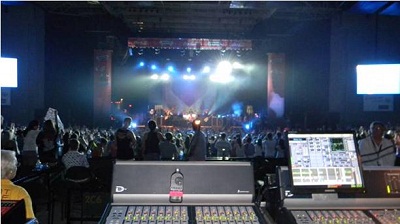
Figure 1. View of stage from engineer sound board at Bamboozle Road Show, June 2010.
This means that you have a pretty consistent sound level throughout the whole venue. The guy who is running the front of house figures out how to do the timing. Recall the inverse square law and how sound propagates in terms of time delays due to distance. The sound engineers have to make sure that the reinforcement speakers in the back do not cause any kind of feedback or sound cancelations from the speakers in the front.
Do you see the device sitting on the sound board in Figure 1? That is a cheap sound level meter. These things are fairly inexpensive, small and portable. They are wonderful to have. The audio engineer for All Time Low, which was the act that was on right before Boys like Girls on stage in the picture, put this sound level meter here. I want to show you the data on that sound level meter (Figure 2). What you see is 104 dBA. Of course, the engineer left a little bit of commentary for the Boys like Girls engineer, as well.
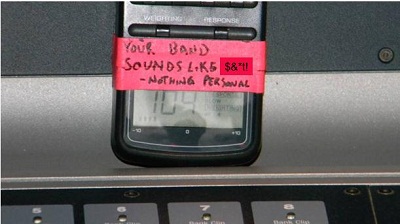
Figure 2. Sound level meter indicating 104 dBA from live music at Bamboozle Road Show, June 2010.
The point that I want to make is that the levels we are talking about with these live music acts are some pretty hefty sound exposures. Frank Wartinger was co-author with me on an article published in Audiology Today (Fligor & Wartinger, 2011) where we made a sound assessment during this Bamboozle Road Show. The show lasted a full four hours of actual music, and the average equivalent continuous level was 105 dBA. For a person who was there in their seat for the full five hours and did not get up to use the bathroom or go get a beverage or would have had a noise dose of 5,000 percent if we use a damage risk criteria of 85 dBA for an 8-hour equivalent continuous level with a 3 dBA exchange rate. I am going to talk about that in just a minute to describe how we come up with a noise dose and put these things in a better perspective.
Let’s say that someone who attended this concert received a 5,000 percent noise dose. One-hundred percent is the maximum recommended exposure level. So a 5,000 percent noise dose is 50 times the allowable exposure for a given 85 dBA 8-hour time period. This is the noise dose for the audience. The levels are quite a bit lower back stage due to the distance factor. But with that said, the crew, when they are doing set up and sound checks, are exposed to fairly high sound levels. We did sound level measures throughout the seven hour period. The crew’s overall equivalent continuous level is 99 dBA, for a total of almost 2,200 percent noise dose (Fligor & Wartinger, 2011). This is 22 times their allowable amount. For an audience member who attends one or two shows a year, a 5000 percent noise dose will likely cause a temporary threshold shift accompanied by some tinnitus. It is even possible that some people in the audience with very fragile ears will be left with some permanent changes in their auditory function.
What I am more concerned about, however, are these crew members. They are not exposed only one or two times a year; they may work 200 shows a year. So 200 times a year they are getting this kind of noise dose. This is a big deal when you are getting this kind of repeated exposure. It is important to protect both groups of people with these kinds of exposures.
As audiologists, we think primarily of two different mechanisms of damage, one being this gradually developing, noise-induced permanent threshold shift. This is a result of being exposed to sound levels between about 78 dBA and 130 dBA. The cut off in the 130s depends on a person’s individual susceptibility to developing noise-induced hearing loss. The primary site of lesion for this kind of hearing disorder is the outer hair cells. This is due to a metabolic overload after some duration of exposure. Those outer hair cells that contribute to the active process of hearing are being driven by these high sound levels and are doing their little jump. Their electromotal tug against the tectorial membrane is transferring energy to the inner hair cell, where the inner hair cell is deflected by the motion of the tectorial membrane. This deflection causes depolarization of the inner hair cell, which releases the neurotransmitter from the inner hair cell across the synapse to the spiroganglion cells, which then causes that cell to fire.
The tug of those outer hair cells, acting like a biological hearing aid, is essentially a compressive non-linear amplifier. That process requires a lot of adenosine triphosphate (ATP), the energy that drives all cells. It requires a lot of glucose and oxygen to do that. When you over-drive the cells, it causes them to deplete their energy source, and the massive waste product that comes from this reactive process causes the cell itself to start to shut down. Do this often enough, and the cell goes through a process of cell death called apoptosis where the cell will break apart and the DNA starts to fragment. Once the DNA starts to fragment in the nucleus, the cell starts to break itself apart while maintaining its cellular structure. The “guts” of the inside of the cell do not leak out and contaminate the rest of the cells around them, but the cell is ejected off of the basilar membrane, floats up into the endolymph and it is swept up by the macrophages.
The empty space where the outer hair cell lived is replaced with the supporting cells around it, which essentially act like scar tissue. However, this process takes a while, and as more and more hair cells are lost, you get this gradual loss in sensory hearing. This is the same process that occurs in a noise-induced temporary threshold shift (NITTS), where the stereocilia on top of the outer hair cell splays out. If the hair cells do not go through the process of cell death, when given time to rest and recover, the stereocilia will stand back up and start to work again.
Moderately intense sounds occur over a period of time. They are not immediate. This is in contrast to an acoustic trauma, which we think of typically happening after some massive impulse or peak sound pressure level, like a rifle or firecracker explosion.
Dick Price published a paper (Price, 1981) showing that that threshold for acoustic trauma might be as low as 132 dB SPL in highly susceptible ears. Hence, my 130 dB cut off between acoustic trauma and noise-induced permanent threshold shift (NIPTS). You can, in fact, get an acoustic trauma of some from a marked overdose of sound. So an acoustic trauma does not have to be only from the rifle or a handgun where the person firing the weapon does not have hearing protection in; it can come from having good seats at a NASCAR event where you get a massive overdose, which I calculated to be around 6,000 to 6,500 percent dose, resulting in some mechanical damage and immediate loss of sensory hearing.
Injury for noise exposure is a function of time and intensity, so not just how loud, but for how long. There is also a frequency component to this, where the middle ear system has an influence on what frequencies are damaging to the inner ear. As a proxy for how energy is transmitted to the inner ear, there is a weighting network. It is a filter that is set on most sound level meters to describe the actual sound exposure over a period of time. That means that 75 dB is an overall level across all the frequencies that are a part of that sound, but then that intensity is filtered through A weighting, which decreases the contribution from very low and from very high frequencies.
As audiologists, we think about NIPTS or temporary threshold shift (TTS) where hearing thresholds often decrease between 3,000 and 6,000 Hz. We generally expect to see a noise notch at 4,000 Hz as well. Other injuries, particularly for musicians, are tinnitus that arises from this chronic exposure, abnormal pitch perception also referred to as diplacusis, and loudness intolerance problems such as hyperacusis, or a sensitivity to loud sound. It is these other injuries of a music-induced hearing disorder that often drives the musician into the clinic and is part of the reason why someone may come in and need to get custom earplugs.
How Loud is Too Loud?
How do we know how loud is too loud? It comes from seminal studies that were conducted back in the late 60’s and early 70’s in the United States and Europe. Noise-exposed factory workers who did not have any hearing protection were studied. They were a “pristine” sample, which is something we do not have anymore. We had these people who have been working for zero years up to their whole working lifetime of 40 years. The idea with this study was that each one of the 792 people represents a data point. You check the hearing of one subject and look at the hearing of another subject and draw the conclusion, “This person here is going to have much worse hearing because they have been exposed to higher levels for a longer time than this other guy down here.” The person who has shorter exposure time but at greater intensities may, in fact, have greater hearing loss than the person who has had the same exposure time, but at a lower sound level. This conclusion does not always work out this way due to individual susceptibility, but as a general rule, a person who has shorter exposure levels will have less hearing loss than a person who has had longer exposures.
Different organizations have weighed in on this debate. The Hearing Conservation Act of 1981 published in the federal register (OSHA, 1981) dictated to OSHA what the minimum standards for listening safety ought to be, or to protect against what is known as a material hearing impairment. A study by Prince, Stayner, Smith and Gilbert (1997) got the standards from the International Standards Organization (ISO), EPA, and the National Institute for Occupational Safety and Health (NIOSH) and analyzed these data and some other data sets (Figure 3). They said, “If we allow people to be exposed to 90 decibels for an 8-hour equivalent continuous level, 21 percent of them are going to sustain a material hearing impairment over their working life time.” The EPA indicated that that number was more like 22 percent, and NIOSH indicated it is more like 29 percent.
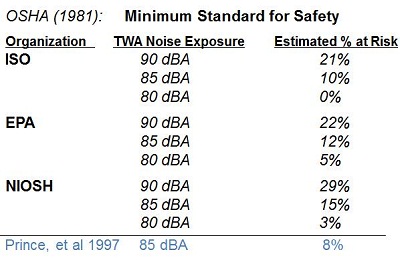
Figure 3. Calculated risk for a material hearing impairment according to ISO, EPA and NIOSH, compared with data from Prince, Stayner, Smith and Gilbert (1997).
If you look at 85 dB as a cut off for that, then 10 to 15 percent of people are going to sustain a material hearing impairment. If you make the cut off 80 dB, it is anywhere from 0 percent up to five percent of people sustaining material hearing impairment. The reanalysis that was performed by Prince and colleagues in 1997, using more up-to-date statistical measures than back in 1968 to 1972, suggested that if our cut off is 85 dB for an 8-hour equivalent continuous exposure, 8 percent of people are going to sustain a material hearing impairment. That is the number that NIOSH has now accepted as best practice. The acceptable recommended exposure level is an 85 dBA weighted time average. OSHA is very pro-business, and they have a damage risk criteria that says that the maximum permissible exposure level is 90 dB for an 8-hour time weighted average, and they allow a five decibel exchange rate. What I mean by a time intensity trading ratio is that if you go up by 5 dB, you cut the allowable exposure time in half, so 95 dBA is acceptable for 4 hours, 100 dBA is acceptable for two hours, and 105 dBA is acceptable for one hour. NIOSH gives an 85 DBA time weighted average with a more conservative 3-dB exchange rate. The most conservative criterion is promoted by the EPA, which indicates 80 dBA for an 8-hour time weighted average with a 3 dB exchange rate. This is the most protective and this is the most permissible. So how does this pan out?
The NIOSH standard is obviously the middle ground with an 85 dBA exposure with a 3 dB exchange rate. If 85 dBA for eight hours is our maximum recommended exposure level, that would constitute a 100 percent noise dose, so 88 dB for 4 hours is 100 percent, 91 dB for 2 hours is 100 percent, and 94 dB for 1 hour is 100. On the other side of this, that means that 88 dB for 8 hours is a 200 percent noise dose and 91 dB for 8 hours is 400 percent. You get the idea.
So what is a material hearing impairment? The NIOSH (1998) definition is a weighted average of greater than 25 dB HL across 1,000, 2,000, 3,000 and 4,000 Hz. By 85 dBA 8-hour equivalent continuous level with a 3 dB exchange rate, 8 percent of people who are exposed to that “safe level” will sustain this kind of hearing impairment. I am going to play this sound sample, which is music through a normal-hearing system.
Here is that same sound file but through the ears of one of those 8-percent of people who happen to have the more tender ears and were exposed to 85 dBA 8-hour equivalent continuous level.
Those cricket-like sounds that you hear is tinnitus that I overlaid. Just as quick demonstration, here is the normal sample again.
You can all probably agree that 85 dBA for an 8-hour time weighted average is actually not safe; it is just safer than OSHA’s standard, and it is safer than no criteria at all. That is the background to understanding how we establish a hearing loss prevention program.
Music Exposure
Our application of music exposure follows right along with the industrial or occupational sectors. We do a noise survey, also. At the Bamboozle Road Show, I showed you that there was a 5,000 percent noise dose for an audience member who never gets out of their seat. Engineering administrative controls are something typically put in place by the occupational sector, but they are hard to implement in the music sector for exposures. Audiometric monitoring is something that obviously needs to be done for anyone obtaining musicians earplugs. That patient is getting them because they are exposed, and perhaps we want to find out where their hearing is, at least as a baseline. Education and motivation is something that the industrial audiologist struggles to successfully relate to patients. Those workers are having their hearing tested as a requirement; not necessarily out of care for their hearing. If the person shows up voluntarily in your clinic, they obviously care and are motivated. Maybe they have experienced some temporary threshold shift or some tinnitus.
A first line of defense that we often think of for a hearing loss prevention program is fitting musicians’ earplugs or hearing protection devices. I have to give Kris Chesky some credit on this one, but we have to heighten the awareness that when we fit a person with a hearing protection device, we are accepting that these other four tenants of a hearing loss prevention program (noise survey, engineering controls, audiometric monitoring and education) have failed to protect a person against risk for a music-induced hearing disorder. Therefore, we are submitting to the method of last resort, which is a hearing protection device.
We have accepted that this person may well develop a hearing loss because of what they want to do, and so we are sticking a device in their ear hoping that it is going to achieve the desired outcome of preventing hearing loss, right? When worn properly, these devices really can achieve that. Figure 4 is Benj Kanters’ son, Micah Kanters. Benj is that audio engineer from Columbia College. Micah goes to a lot of raves, and his dad got these earplugs for him because of the high noise exposure at these kinds of dance clubs.
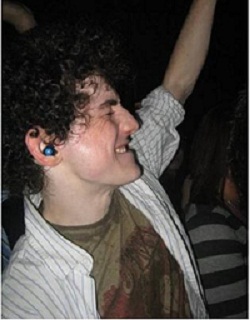
Figure 4. Musicians earplugs in place at a concert.
Figure 5 is a commercial airline pilot who flies from Eastern Europe down to South Africa fairly regularly. He is also wearing musicians earplugs because he uses circumaural communication headsets over them. These flat frequency attenuators allow him to still hear and understand what the air traffic controllers are telling him. He does have some hearing loss, and he is looking to arrest that.
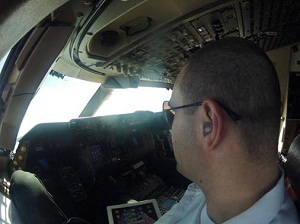
Figure 5. Airline pilot wearing flat-attenuation musicians earplugs during commercial flights.
The idea of a flat frequency attenuator is that it is going to attenuate low frequency to high frequency at about the same level in order to preserve the normal frequency content. Musical notes consist of a fundamental frequency. For example, the note A above middle C on the musical scale has a fundamental frequency of 440 Hz. Every instrument has its own unique sound signature with integral harmonics. The first harmonic, second and third harmonics for this note are 880 Hz, 1220 Hz and 1580 Hz, respectively. This means that the fundamental at 440 Hz is where the most energy occurs. But then you have energy at 2 times 440, energy at 3 times 440, energy at 4 times 440 Hz, et cetera. It is the relative ratio of those harmonics to the fundamental that give the instrument the sound quality and distinguishes it as a piano or guitar. Maintaining that acoustic structure is important for preserving the timbre of the musical instrument.
When we put a hearing protection device in the ear that is not, in fact, flat, then we are manipulating or distorting that harmonic structure. The idea with a flat frequency attenuator is that there are custom components that keep the musical timbre. There is a button filter that sits on the outside of the plug that acts as acoustic resistance, capacitance and inductance. Then there is a custom-fitted sleeve that truly should extend down to the second bend or the bony portion of the ear canal. The resonating chamber approximates the volume of the open ear canal, and that acts as an acoustic inductance.
If there is a problem with the actual sleeve itself, then we are going to alter the frequency response. That is what we are going to talk about here today. The transfer function of the open ear (Figure 6) is equal to A minus B, with A being the value obtained from down in the ear canal and B, the sound level outside of the ear.
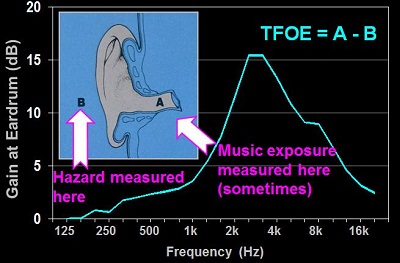
Figure 6. Transfer function of the open ear.
The transfer function of the open ear is A minus B, and we see that there is about 15 dB of gain right around 2,000 to 4,000 Hz. This is the ear canal resonance that we need to be able to preserve. How do we do that? How do we know whether or not we have preserved that when we stick a device in somebody’s ear?
Erin is a musician patient of mine, and she has given me permission to use her image (Figure 7). Here I have the probe microphone system from a real-ear verification unit. The probe is placed down her ear canal within two millimeters of her ear drum as she is playing her instrument. I did some sound level measures from her instrument, and determined she needed musicians’ plugs. She had tinnitus in her left ear when she went from practicing 60 minutes a day to 90 minutes a day in order to get good at her instrument.
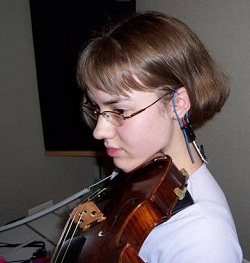
Figure 7. Probe microphone measures taken during practice of a musical instrument.
I fitted Erin with musician’s plugs, and to determine whether or not they work well, we use probe microphone measurements. The principle complaint against using hearing protection devices is that they cause muffling and distortion. This is something I discussed in detail just a few minutes ago- the change in timbre of the music. Changing the harmonics relative to the fundamental frequency and loss of the natural ear canal resonance causes distortion.
Figure 8 shows the frequency response if I had stuck a foam earplug in my ear and listened to a music stimulus. The green line shows the unoccluded open ear response. If you look at that pink line, which is the response measured with a foam earplug, you will notice that the original ear canal resonance that occurred between 2,000 and 4,000 Hz is gone.
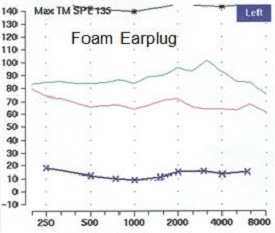
Figure 8. Ear canal resonance of an ear occluded with a foam earplug (pink line) compared to the open ear response (green line).
When measured with an ER-15 Musicians Earplug in place (Figure 9), we see that the attenuated response follows along pretty well, but the natural ear canal resonance is better maintained in the 2,000 to 4,000 Hz range.
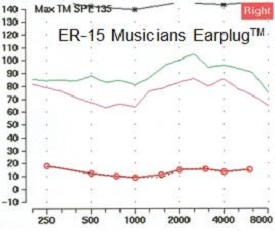
Figure 9. Ear canal resonance of an ear occluded with a filtered musicians earplug (pink line) compared to the open ear response (green line.)
It is important to make routine measures with the earplugs to ensure that they are providing the right attenuation and that the response is satisfactory. These earplugs can become clogged or the ear can change, causing a different fit, thus affecting the response. You can use any hearing aid verification system where you can run a maximum power output (MPO) measure. To make the measurement with the plug in, put a dab of otoease or other water-based lubricant on the sleeve of that musicians earplug and then you place that musicians earplug down in place again and look.
The big concern about putting the probe microphone in the ear and inserting the sleeve over the top of it is that it we may introduce a slit leak which will act like a vent. Even a very small vent will introduce a slit leak, and that will show up down in the low frequency range. The otoease helps to seal any leak that may occur.
The well-fitted ER-15 in one patient (Figure 10) provided a range of isolation of 15 dB to 21 dB from 200 Hz up to 8,000 hertz. The 15 in the name of the plugs denotes the attenuation, and the average across all frequencies was 16.4 dB in the left ear and 17 dB in the left ear, with a standard deviation of 2.2 dB in the right ear and 3.6 dB in the left ear.
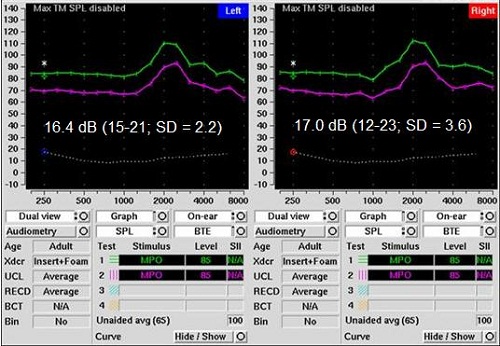
Figure 10. Left and right ear verifications of ER-15 flat frequency attenuators. The left ear achieves an average of 16.4 dB attenuation, while the right ear achieves 17 dB.
Let’s compare that to another pair of earplugs from the same manufacturer. I verified 15 dB of sound isolation, but the range was 0 to 27 dB of sound isolation with a standard deviation of 9.2 dB. Anecdotally, the person that I fitted these on, “Yeah, I don’t know.” I did, in fact, take new earmold impressions, and I sent them back. Why do some plugs have this kind of response with this range of sound isolation even though they provide nominally 15.5 dB?
Mead Killion and his colleagues published a study in 1988 to explain performance characteristics. Dr. Killion gave a talk at the Audio Engineering Society conference on music-induced hearing disorders. Again, the construction of the ER-15 has an outer acoustic resister, and then there is the sleeve itself with the sound bore acting as an acoustic inductance. And for those engineers, we recognized the electrical model of it. In a 15 dB sound isolating plug that is correctly fit, the attenuation follows the open ear response almost precisely. If we have a poor seal, there is no attenuation, but rather a gain in the low frequencies. Remember, I talked about that slit leak caused by the earplug being in place. If a low-frequency leak is not due to the probe microphone, it can be due to the sleeve. It can be too short, it does not go in deep enough, or it is not tightly sealing the ear canal. It ends up with a lot of bassy low pitch, and it sounds dirty. There is bleed-in, and we are not providing the kind of isolation that we need. This paper is available on the Etymotic web site (https://www.etymotic.com/publications/erl-0014-1988.pdf)
Now, I talked also about having this sound bore that is the acoustic inductant. If it is not approximating the volume of the open ear, we get a shift in the peak resonance relative to the open ear and that distorts the sound. A poor seal with an undersized sound channel deviates greatly from the desired attenuation. What we need is an earmold down past the second bend, down in the bony portion of the ear canal. This deep impression gives the lab that is fabricating these earplugs all of the anatomical data needed for the direction of that sound bore. We need to use a material that is not terribly soft when we are making the earmold impression so that it does press against the skin of the ear and the ear canal and makes a tight impression.
I personally mandate that any lab that I get my musicians earplugs from have been validated by Etymotic research, and that they have an acoustic mass meter to verify this sleeve. It should pass specification for the acoustic mass of this sound bore. I prefer to use labs that make these earplugs out of a medical grade silicone and not out of vinyl or poly-vinyl material. I am referring to clear silicone as opposed to the flesh colored vinyl. While I can acknowledge that the vinyl is easier to insert and remove, it also shrinks over time which will result in a poor seal. The silicone does not shrink.
What would happen if we had an audience member at the Bamboozle concert using an ER-15? Instead of getting a 5,000 percent noise dose, they would get a 158 percent dose (Fligor & Wartinger, 2011), ever so slightly overdosing relative to the NIOSH criteria, but boy, is that safe and, in fact, pretty good. You could be exposed to that several times in a given month and not add any risk. For the crew, musicians or anyone there who is exposed 200 times a year, when using the ER-15, there was only a 70 percent noise dose. That is outstanding.
By comparison, a foam plug is nominally providing 20 dB of sound isolation. It is a little better in terms of attenuation, but the sound quality is terrible for the reasons we talked about during this whole course. The ER-9 attenuator is not necessarily the right way to go in these circumstances because it is definitely overexposing at 277 percent noise dose (Fligor & Wartinger, 2011). So the ER-15 is a great call here.
People should be counseled appropriately for where their hearing falls and incorporate the use of musicians earplugs that are appropriately verified to assure that they are in fact providing the amount of isolation that has been prescribed to them.
Question & Answer
Do vocalists have a harder time adjusting to plugs than others?
Absolutely they do. One of the issues is that of the occlusion effect where you get your own voice resonating in your ear. Vocalists are going to have a tougher time with it. One of the best ways to manage that is to get as deep a custom sleeve as possible, extending into the second bend. Ask the lab to taper the end a bit for comfort, because if it is pressing against the ear canal in that area, it might be uncomfortable. The deeper the impression, the less occlusion effect you are going to have.
I recommend that all musicians record their performance or practice with the plugs out and with the plugs in. This is not so dissimilar to how athletes video tape themselves to watch their performance. A lot of musicians listen back to their own performance anyway. Have them do it with the plug in and out and help them understand that this is a process of learning how to use the plug. There is going to be some acclimatization there, and it is okay if it takes a little while to get used to.
Awesome sound samples! Are they available for patient counseling? It may help convince patients to get plugs.
I actually do have these sound samples available on my website, the Musicians’ Hearing Program website. I developed the samples through the use of the hearing loss and prosthesis simulator HeLPS, which is a commercially available product from Sensimetrics Corporation (https://www.sens.com/helps/index.htm). Again, I have no commercial interest in that company; I just like the software.
Is there any concern with over-protection of musicians’ plugs on musicians?
Fantastic question. It is precisely the issue that Kris Chesky has raised. Yes, there is concern about that. Number one is that most musicians do not need more than 15 dB of isolation. They do not need the amount of sound isolation provided by a foam earplug, either. In fact, the only musicians I ever fit the ER-25 to are drummers, because a hard hitting drummer can reach levels up in the 136 dB range on the snare or high hat. That is on par with a 22-caliber rifle, and they are hitting sometimes two to three beats per second. That is a lot of sound exposure. That is why a musician has to record themselves and why they have to get used to it and get some feedback from other people in their band about how their performance is when they are using the plugs.
We can sometimes be concerned with overuse injuries as well. For instance, a drummer puts the plugs in. He starts hitting harder because it doesn’t sound as loud, so he hits harder to achieve that same loudness. That can result in tendonitis in his arm. We certainly do not want to do that. In a vocalist, it can lead to vocal strain. You certainly do not want anything like that to result in vocal nodules. This is where the audiologist comes in to help people learn how to monitor differently with the plug in place. That is our job. We are the hearing expert helping them to listen to themselves differently through a well-fitted flat frequency attenuator that we have, in fact, verified as being flat.
References
Fligor, B.J. & Wartinger, F. (2011). Musicians’ hearing program. Audiology Today, 23(3), 30-40.
NIOSH. (1988). A proposed national strategy for the prevention of noise-induced hearing loss. Chapter 8 in Proposed National strategies for the Prevention of Leading Work-Related Diseases and Injuries, Part 2. National Institute for Occupational Safety and Health: Cincinnati, OH.
OSHA. (1981). Occupational Safety and Health Administration, Occupational noise exposure: Hearing conservation amendment. 46 Fed. Reg. 4078-4179.
Price, G. R. (1981). Implications of a critical level in the ear for the assessment of noise hazard at high intensities. Journal of the Acoustical Society of America, 69, 171-177.
Prince, M.M., Stayner, L.T., Smith, R.J., & Gilbert, S.J. (1997). A re-examination of risk estimates from the NIOSH occupational noise and hearing survey (ONHS). Journal of the Acoustical Society of America, 101(2), 950-963.


